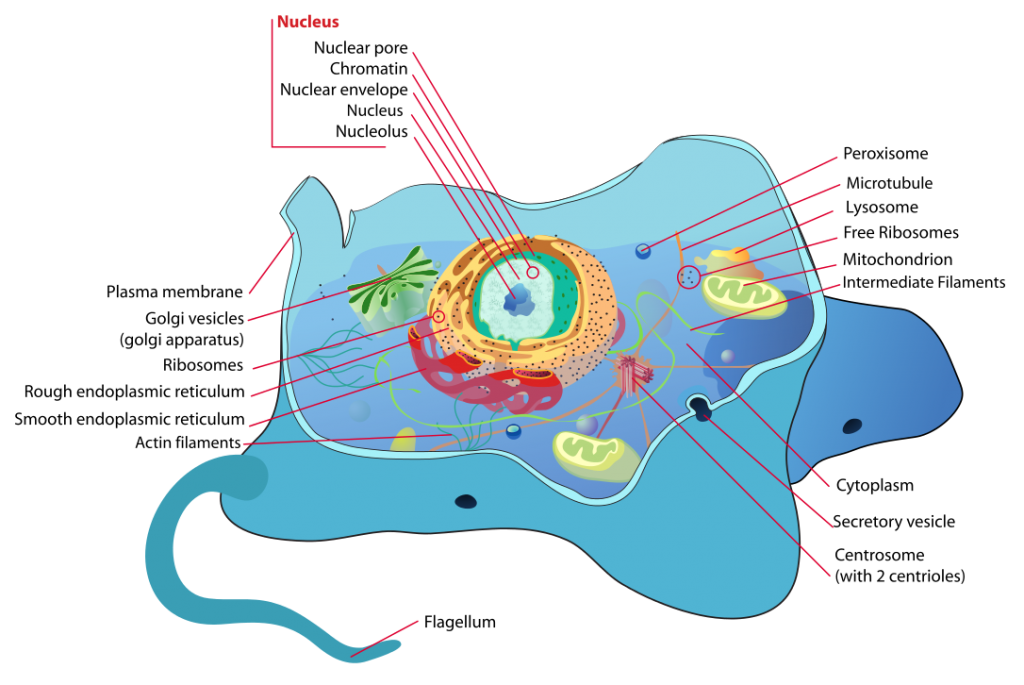Animal cells are heterotrophic cells, in the members of the kingdom Animalia. They lack cell walls, plastids, and ability to perform photosynthesis. They are typical eukaryotic cells characterized by the presence of a well-defined nucleus and membrane-bound cell organelles.
Index
History
German scientists Schwann and Schleiden were the first to observe and study animal cells.
Structure

Animal Cell consists of Protoplasm (=Protoplasm).
The Protoplasm subunits are,
- Plasma Membrane,
- Cytoplasm, and
- Nucleus.
The cytoplasm is distinguishable into Cytoplasmic Matrix (=Hyaloplasm) and Cell Organelles. Protoplasm (=Protoplast): It is the living part of the cell.
- Plasma Membrane: Discovered by Shwann in 1838, the term Cell Membrane originally used by Nageli and Cramer in 1855. The plasma membrane is selectively permeable for solutes and semi-permeable for water. It is dynamic, i.e., any injury can be repaired in no time. It composes of lipids (20-79%) and proteins (20-70%), and carbohydrates (1-5%). Plasma membranes cause the compartmentalization of cells as they separate the cell from the outer environment and allow it to maintain its functional individuality. It also regulates the flow of information and materials from one cell to another.
- Cytoplasm: The cytoplasm is jelly-like semi-fluid, containing the cytoplasmic matrix, cell organelles, and cell inclusions. The cytoplasmic matrix (the cytosol) is a crystal-colloidal complex comprising 90% water. Matrix contains various biomolecules, like minerals, sugars, amino acids, vitamins, proteins, enzymes, etc..
- Mitochondria: Mitochondrion (pl. Mitochondria) is a double membranous organelle. Found in cells of aerobic eukaryotic organisms. Popularly known as the “Powerhouse of the Cell”, it produces ATP by oxidative phosphorylation.
- Ribosomes: Ribosomes are giant macromolecules in the cytoplasm, which serve as a site for protein synthesis. MAde up of proteins and RNA, they are naked (i.e., not bound by a membrane) with a length of 200-340 A and diameter of 170-240 A. They are popularly called “protein factories.”
- Endoplasmic Reticulum: Endoplasmic Reticulum (ER) is a continuous and complex system of interconnected flattened membranous sacs and tubules that runs through the cytoplasm. It divides the cytoplasm into two compartments- luminal (inside the ER) and extraluminal (rest of the cytoplasm). It provides mechanical support by serving as a skeletal framework and is responsible for producing various proteins and lipids.
- Golgi Apparatus: Golgi apparatus or Golgi complex is a system of stacks of flattened, membrane-bound sacs, vesicles, and tubules that participate in the transformation, secretion, and production of complex biochemicals.
- Lysosomes: Lysosomes are small vesicles enclosed by a single impermeable membrane. It contains hydrolytic (digestive) enzymes in the form of granules which can be crystalline or semicrystalline. They are popularly called “suicide bags” of the cell.
- Vacuoles: These are non-cytoplasmic compartments enclosed by a membrane
- Nucleus: It is a specialized double membranous body that carries all the hereditary information in the form of a genome. It is the control center for cell metabolism and cell Differentiation. It is the site of synthesis and/or replication of DNA, RNA, and ribosomes.
Difference between Plant Cell and Animal Cell
| Plant Cell | Animal Cell |
| A Plant Cell has a rigid wall which gives it a definite form and shape. They are usually larger. | In Animal Cells, the cell wall is. Absent, allowing them flexibility In terms of structure. They are Generally smaller in size. |
| Plastids are present in plant cells. Some specialized plastids containing chlorophyll can perform photosynthesis in the presence of sunlight. | Plastids are absent. Chlorophyll is absent. Animal cells are incapable of performing photosynthesis. |
| Plant cells have a large central vacuole. | An animal cell has many small localized vacuoles. |
| The nucleus lies on one side of the periphery due to a large central vacuole. | The nucleus is generally present in the center. |
| Mitochondria are comparatively fewer as plants require less energy to function. | Mitochondria are generally Numerous as animal cells are metabolically more active. |
| Plant cells can tolerate hypotonic solutions (they won’t burst) due presence of a cell wall. | Animal cells usually burst in hypotonic solution unless they have contractile vacuoles. |
| The Golgi Apparatus consists of a number of unconnected units called dictyosomes. | The Golgi complex is either localized or consists of a well-connected single complex. |
| Glyoxysomes may be present. | Glyoxysomes are absent. |
| Adjacent cells may be connected through plasmodesmata. | Adjacent cells are connected through a number of cell junctions. |
| Cytokinesis occurs by cell plate. | Cytokinesis takes place by cleavage. |
Related Topics:
Questions
- What is an animal cell?
Animal cells are heterotrophic cells found in the members of the kingdom Animalia. They lack cell walls, plastids, and the ability to perform photosynthesis. They are typical eukaryotic cells characterized by a well-defined nucleus and membrane-bound cell organelles.
- Who discovered animal cells?
German scientists Schwann and Schleiden were the first to observe and study animal cells.
FAQs
The cytoplasm of animal cells consists of many cell organelles: Endoplasmic Reticulum, Golgi Complex, Lysosomes, Vacuoles, Ribosomes, Mitochondria, Sphaerosomes, Microbodies, and Nucleus.
Animal cells are heterotrophic. Unlike plant cells, they lack cell walls, plastids, and the ability to perform photosynthesis.
Animal cells usually burst in hypotonic solution unless they have contractile vacuoles. This is due to the fact that they lack a cell wall.
Animal cells do not have plastids and glyoxysomes.
In animal cells, cytokinesis takes place by cleavage.
